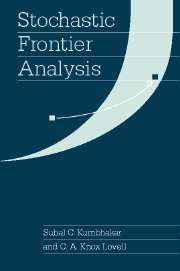Book contents
- Frontmatter
- Contents
- Preface
- 1 Introduction
- 2 Analytical Foundations
- 3 The Estimation of Technical Efficiency
- 4 The Estimation and Decomposition of Cost Efficiency
- 5 The Estimation and Decomposition of Profit Efficiency
- 6 The Shadow Price Approach to the Estimation and Decomposition of Economic Efficiency
- 7 Incorporating Exogenous Influences on Efficiency
- 8 The Estimation of Efficiency Change and Productivity Change
- References
- Author Index
- Subject Index
4 - The Estimation and Decomposition of Cost Efficiency
Published online by Cambridge University Press: 05 June 2012
- Frontmatter
- Contents
- Preface
- 1 Introduction
- 2 Analytical Foundations
- 3 The Estimation of Technical Efficiency
- 4 The Estimation and Decomposition of Cost Efficiency
- 5 The Estimation and Decomposition of Profit Efficiency
- 6 The Shadow Price Approach to the Estimation and Decomposition of Economic Efficiency
- 7 Incorporating Exogenous Influences on Efficiency
- 8 The Estimation of Efficiency Change and Productivity Change
- References
- Author Index
- Subject Index
Summary
INTRODUCTION
In Chapter 3 we considered various approaches to the estimation of technical efficiency. The standard against which technical efficiency was estimated was provided by the production frontier, and we adopted an output-oriented approach to the estimation of technical efficiency. In this chapter we consider various approaches to the estimation of cost efficiency. The standard against which cost efficiency is estimated is provided by the cost frontier, and we adopt an inputoriented approach to the estimation of cost efficiency.
Several significant differences between the estimation of outputoriented technical efficiency and the estimation of input-oriented cost efficiency should be noted.
The first difference concerns data requirements. The estimation of technical efficiency requires information on input use and output provision, whereas the estimation of cost efficiency requires information on input prices, output quantities, and total expenditure on the inputs used, and depending on the model, perhaps input quantities or input cost shares as well. The data requirements for the estimation of cost efficiency are more onerous in some situations and less onerous in others.
The second difference concerns the number of outputs. Estimation of a cost frontier can be accomplished in situations in which producers produce multiple outputs, whereas estimation of a production frontier requires that producers produce a single output. To use quantity data on multiple inputs and multiple outputs to estimate technical efficiency requires the estimation of either of the two distance functions introduced in Section 2.2.3.
- Type
- Chapter
- Information
- Stochastic Frontier Analysis , pp. 131 - 183Publisher: Cambridge University PressPrint publication year: 2000



